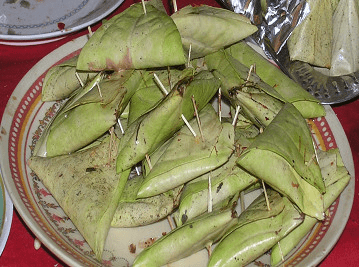Betel quids, also commonly referred to as betel nuts, are the fourth most commonly used psychoactive substance in the world. Only tobacco, alcohol and caffeinated beverages are more commonly consumed. Approximately 600 million people worldwide, mostly on the Asian continent, chew betel quids regularly. The habit is most commonly seen in southern Asia, from southern China down to Indonesia and Papua New Guinea. Betel quid chewing is also seen in selected other countries, such as Kenya and South Africa. The United Kingdom, where the trafficking of areca nuts is not regulated, also sees large numbers of betel quid chewers in areas with large Asian populations. The habit is less common in the European Union, where the sale of oral tobacco products is forbidden, and even less common in the United States, where the trafficking of areca nuts is forbidden. The chewing of betel quids dates back to the Bronze Age. In some places, betel quids have gained cultural or even religious importance. They are used as pain relief, as an aphrodisiac, and even to treat acne. However, chewing betel quids has also been found to increase a person’s risk of oral cancer. Betel quids are composed of areca nuts wrapped in betel leaves. They may contain spices such as cardamom, saffron, cloves, turmeric, aniseed or mustard. They may also contain some kind of sweetener, and they frequently contain tobacco. The little parcels are then coated in slaked lime, which is made of water mixed with powdered calcium hydroxide derived from shellfish, corals or limestone. Betel quids are generally cheap compared to cigarettes, and they can be sold to children as well as adults. The use of betel quids turns saliva red, and years of chewing these products eventually leave permanent reddish black stains on users’ teeth. In some places, chewing betel quids has been outlawed in an attempt to rid public areas from the red saliva regularly spit by betel quid chewers. Examinations of the saliva of betel quid users have revealed carcinogens derived from tobacco and areca nuts. A link between oral cancer and betel quids was established as early as the 1990s. This risk of cancer exists whether or not the betel quids contain tobacco, suggesting that the areca nuts themselves have carcinogens that are released or created during the chewing process. Even the slaked lime that coats the betel quids may be a hidden threat, because it is suspected of speeding the process by which carcinogens are released into the mouths of chewers.
Public Slow to Recognize the Health Risk
Despite the fact that information about the dangers of betel quids has been available for nearly two decades, the public has been slow to accept the idea that this popular habit may be harmful. The popular view of betel quids is that they are healthier than smoking cigarettes. This idea is all the more firmly entrenched because betel quids tend to be much less expensive than cigarettes. Dubious information about the dangers of betel quids may also contribute to the public’s skepticism. Some betel quid opponents have claimed that pesticides used on areca nuts are the source of the carcinogens that result from betel quid chewing. But research has never connected pesticides with oral cancer, and pesticides are rarely used on areca nuts in any case, since the plants are naturally pest-resistant. However, the biggest reason that health warnings have so far failed to make much of a dent in betel quid chewing is that the parcels, like cigarettes and chewing tobacco, are highly addictive. As a result, the betel quid chewing habit is as difficult to overcome as other substance addictions. Betel quids have also become very popular among truck drivers, taxi drivers, stall vendors and other people who work long hours every day. The betel quids help them to stay awake, and many justify their habit because they have come to rely on the stimulation from the quids to earn their living.

